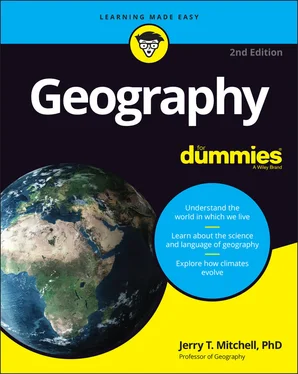Jerry T. Mitchell - Geography For Dummies
Здесь есть возможность читать онлайн «Jerry T. Mitchell - Geography For Dummies» — ознакомительный отрывок электронной книги совершенно бесплатно, а после прочтения отрывка купить полную версию. В некоторых случаях можно слушать аудио, скачать через торрент в формате fb2 и присутствует краткое содержание. Жанр: unrecognised, на английском языке. Описание произведения, (предисловие) а так же отзывы посетителей доступны на портале библиотеки ЛибКат.
- Название:Geography For Dummies
- Автор:
- Жанр:
- Год:неизвестен
- ISBN:нет данных
- Рейтинг книги:5 / 5. Голосов: 1
-
Избранное:Добавить в избранное
- Отзывы:
-
Ваша оценка:
- 100
- 1
- 2
- 3
- 4
- 5
Geography For Dummies: краткое содержание, описание и аннотация
Предлагаем к чтению аннотацию, описание, краткое содержание или предисловие (зависит от того, что написал сам автор книги «Geography For Dummies»). Если вы не нашли необходимую информацию о книге — напишите в комментариях, мы постараемся отыскать её.
Geography For Dummies
Geography For Dummies
Geography For Dummies — читать онлайн ознакомительный отрывок
Ниже представлен текст книги, разбитый по страницам. Система сохранения места последней прочитанной страницы, позволяет с удобством читать онлайн бесплатно книгу «Geography For Dummies», без необходимости каждый раз заново искать на чём Вы остановились. Поставьте закладку, и сможете в любой момент перейти на страницу, на которой закончили чтение.
Интервал:
Закладка:
Most of you have probably not used a GIS, but you’ve come close. Whenever you use an online mapping service to find your way between two cities, you’ve had a simple GIS-like product at your fingertips. There’s a base map, there’s data — say restaurants or hotels — and you have the ability to “query.” Encoded into that map is not just locations but whether a street is one-way or not, and so on. As a result, your query about directions results in a selection of best paths for you to take, usually based on distance or time.
 In the 1967 movie, The Graduate , moviegoers were told that the future is in plastics. Book mark this page now. The real future is in geospatial technology with GIS at the lead!
In the 1967 movie, The Graduate , moviegoers were told that the future is in plastics. Book mark this page now. The real future is in geospatial technology with GIS at the lead!
Global Positioning Systems
Few things are more important in cartography than the positional accuracy of mapped objects. Historically, this was accomplished by field observation. That is, explorers or surveyors would travel to a particular area, observe locally important features, and map their locations. Nowadays, GPS (global positioning system) technology has greatly contributed to positional accuracy. Think about exactly how accurate our spatial data needs to be for self-driving cars to work!
While you may think of GPS as the nice voice that gives you directions in your car, have you ever thought about the system that makes it all happen? The United States has launched a series of satellites (31 operational at the time of writing) that talk to a GPS receiver, often now in your smart phone. The United States is not alone here. Russia, China, India, Japan, and the European Union all have systems, so geographers are now likely to refer to a Global Navigation Satellite System to encompass it all.
Using trilateration — or measuring distances — the receiver and satellite bounce signals between each other and record the time the signal takes to be read. With three satellites doing the same thing, we can accurately locate you on Earth by putting you in the middle of a satellite Venn diagram. Add a fourth satellite and we can determine your elevation.
 There are a number of really neat smart phone apps that allow you to collect data with accurate locations and other ones that allow you to get outside and play (and I mean, play!). Try geocaching some time, where you use GPS to undertake little treasure hunts. You’ll learn something about your local environment, engage with cool technology, and probably get some exercise at the same time. What could be better?
There are a number of really neat smart phone apps that allow you to collect data with accurate locations and other ones that allow you to get outside and play (and I mean, play!). Try geocaching some time, where you use GPS to undertake little treasure hunts. You’ll learn something about your local environment, engage with cool technology, and probably get some exercise at the same time. What could be better?
Remote sensing
Getting information remotely is the game, here. In other words, someone — or rather, something — is doing the work for you. In remote sensing we are talking about gathering information at a distance, and mainly about Earth from above. This might be aerial photography from a balloon all the way to infrared imagery from a satellite hundreds of miles above you, and much of this information now makes up the base maps used in a GIS.
Numerous satellites monitor and provide map-ready information about Earth’s surface and atmosphere. Virtually all of them utilize non-photographic scanners that produce thermal, infrared, or radar imagery. This information is processed and assembled into photo-like images. But we also use digital photography taken by aircraft or drone, and each type of sensor has special advantages.
Aerial photography
Aerial photography refers to photos of Earth’s surface taken from aircraft. Today many maps produced under government approval at all levels, municipal through federal, are directly derived from aerial photography. Black and white film was a widely used medium historically, but today almost all of this is done with digital cameras.
Infrared photography is also very popular. Infrared energy is contained in the sunlight that strikes Earth and reflects off its surface. You and I can’t see it, but special types of sensors can. Infrared energy readily passes through haze and air pollution, resulting in crisp images even on days when the atmosphere is far from clean.
Because of that very desirable characteristic, infrared photography is widely used in aerial surveys.
 The gray tones and colors on an infrared photograph may be very different than those observed on regular black and white or color film. Because of that, the term false color is widely applied to infrared film and photographs. Most bizarrely, vegetation appears red. Indeed, the more lush or healthy the vegetation, which appears downright green to you and me, the redder it appears on an infrared photo. Differences in redness may indicate different kinds of crops or forests, or indicate plant life that is stressed because of disease or drought.
The gray tones and colors on an infrared photograph may be very different than those observed on regular black and white or color film. Because of that, the term false color is widely applied to infrared film and photographs. Most bizarrely, vegetation appears red. Indeed, the more lush or healthy the vegetation, which appears downright green to you and me, the redder it appears on an infrared photo. Differences in redness may indicate different kinds of crops or forests, or indicate plant life that is stressed because of disease or drought.
Non-photographic imagery
 Like infrared photography, other remote sensing technologies record surface features in ways that are beyond the capabilities of human eyesight and normal cameras and film. Virtually all of them make use of sensors that scan Earth and record surface information electronically. In the lingo of remote sensing, you have aerial photographs (terminology left over from using film) and non-photographic images. Several image-types are widely used:
Like infrared photography, other remote sensing technologies record surface features in ways that are beyond the capabilities of human eyesight and normal cameras and film. Virtually all of them make use of sensors that scan Earth and record surface information electronically. In the lingo of remote sensing, you have aerial photographs (terminology left over from using film) and non-photographic images. Several image-types are widely used:
Radar imaging: In radar imaging, a sensor emits continuous beams of energy that bounce off Earth and return to the sensor, which records them. Because the emitted beams travel at a known and uniform speed, the time that it takes them to make the round trip is a function of the elevations of the locations where the beams reflect. For example, a beam that bounces off a mountaintop takes less time to return to the sensor than one that reflects off a valley bottom. This information can be used to produce detailed images of terrain and very exact topographic maps.Radar beams can penetrate clouds and fog with no loss of strength. Thus, radar imaging is extremely useful for monitoring and mapping Earth’s surface in regions where atmospheric characteristics inhibit aerial photography (such as characteristically cloudy equatorial areas). It may also be used at night to the same effect as day. The same, of course, cannot be said of regular film.
Thermal imaging: Thermal scanners (a form of infrared imaging) record heat differences on Earth’s surface. This is particularly useful for mapping ocean surface currents (whose temperature variations have a major effect on weather and climate) as well as for identifying and mapping different kinds of pollution. It has also proved very useful in mapping and monitoring forest fires and other fire-related phenomena, especially in situations in which smoke prohibits analysis by means of standard photography.
LiDAR (Light Detection And Ranging): This has really come into its own over the past two decades, primarily for its ability to make very high-resolution maps. Using laser pulses, the system has helped us better map ocean bottoms ( bathymetry ) and helped archaeologists find sites under vegetative cover. LiDAR highlights that mapping is never really done. Sure, there are always new things to map but as LiDAR shows us there are always new, better, and increasingly more accurate ways to do so.
Читать дальшеИнтервал:
Закладка:
Похожие книги на «Geography For Dummies»
Представляем Вашему вниманию похожие книги на «Geography For Dummies» списком для выбора. Мы отобрали схожую по названию и смыслу литературу в надежде предоставить читателям больше вариантов отыскать новые, интересные, ещё непрочитанные произведения.
Обсуждение, отзывы о книге «Geography For Dummies» и просто собственные мнения читателей. Оставьте ваши комментарии, напишите, что Вы думаете о произведении, его смысле или главных героях. Укажите что конкретно понравилось, а что нет, и почему Вы так считаете.












